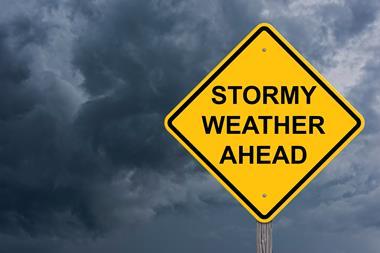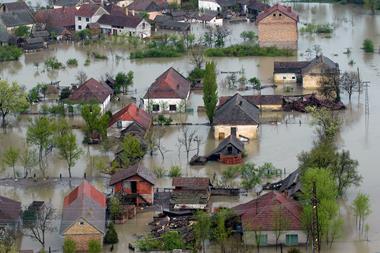Delegates attending a recent Insurance Times and ICEYE roundtable explained that the increased frequency of storms was stretching the industry’s resources to the limit
As ongoing climate change continues to increase the costs and frequency of storms and flood risk in the UK, the insurance sector urgently needs to face into the challenge of improving its strategies to protect customers and increase resilience.

Delegates attending this month’s Flood roundtable (22 April 2024) – hosted by Insurance Times and sponsored by satellite-powered disaster management technology provider ICEYE – explained that while storms have hit sporadically in the past year, their increased frequency was stretching the industry’s resources to the limit.
In early 2024, the UK remained highly vulnerable to severe weather, exemplified by Storm Henk’s arrival, with heavy rain and strong winds having continued throughout the week.
This resulted in flooding across several parts of the UK, with many residential and commercial properties damaged.
Meanwhile, some areas faced flooding for the fourth time in the winter of 2023, owing to storms like Gerrit in late December, as well as Babet, Ciaran and Debi in October and November.
In turn, home insurance claims for weather-related damage reached a record £573m last year, according to the Association of British Insurers (ABI).
This was over 36% higher than in 2022, when the total was £421m, with the rise largely fuelled by a succession of storms – including Babet, Ciaran and Debi.
And according to the Health Effects of Climate Change (HECC) in the UK: 2023 report, published in July 2023, the frequency and magnitude of flooding events is projected to increase in the UK.
Commenting on the impact of storms, Andy Bord, chief executive at Flood Re, explained that these storms were a “reminder that [the need for flood resilience] has not gone away” – both for customers and the industry alike.
“At Flood Re, we’ve seen about a third of the total 7,500 claims we’ve had across the last eight years just in the year through to March 2024. This reflects how significant the work is [needed to be done].”
Louise Clark, general insurance policy adviser at the ABI, echoed Bord’s sentiments as she explained that flood resilience was a “young market”.
However, Clark noted that the industry was “definitely starting to think about how [it] can be more resilient and resistant to floods going forward”.
“Flooding is very traumatic, but is exactly what insurance is there for,” said Clark.
Bord also noted the industry has “stepped up” with initiatives such as Build Back Better to initiate meaningful change and “make a difference”.
Build Back Better was launched in April 2022, to offer policyholders the opportunity to install property flood resilience measures up to the value of £10,000 when repairing their properties after a flood.
At present, Flood Re is observing that roughly a third of claims have a Build Back Better element incorporated into them.
However, Bord cautioned that what Flood Re had observed is “only the tip of the iceberg.” He explained this was because “by definition, you would have been flooded before getting protected against the next flood” in the Build Back Better scheme.
Resources
Despite initiatives like Build Back Better being welcomed by the industry to assist in building flood resilience, the frequency of storms and floods has increased, leading to a higher demand for resources.
Read: Bill Bradshaw – FM Global able to take ‘a really long-term view of risk’ where climate is concerned
Read: Briefing – Industry needs to deliver clarity on climate approach
Explore more sustainability-related content here or discover other news analysis content here
David Williams, an insurance industry consultant and non-executive director at Qlaims, explained: “When you have a big [storm], it is like a Dunkirk experience – everyone is in it together.”
However, he expressed concern that insurers’ contingency plans relied on the same limited resources, causing delays in reaching customers and shortages of equipment.
He continued: “What happens is the storm will still be in progress and we’ll get a note from the ABI asking us how much it’s going to cost”.
This situation prompts everyone to “scurry around” and work on figuring out the details or solutions, explained Williams.
“Whether it’s a big event or a succession of smaller events, the capacity of the supply chain – whether it’s loss adjusters with the right kind of experience and capability, or disaster restoration firms – is becoming more of an issue.”
Anthony Doyle, property and technical claims manager at Allianz, drew from his loss adjuster experience and echoed Bord’s sentiments. He explained that within the industry the amount of loss adjusters was scarce and “most insurers use the same loss adjusters”.
This leads to the capacity of loss adjusters becoming strained, whether responding to a major event or a series of smaller ones.
In turn, from the perspective of insurers, there is then competition to be first to access those same resources.
Paul Sowden, strategic account manager at ICEYE, explained that two customers facing the same flooding situation could have different claims experiences based on the promptness of the response from the loss adjuster.
One customer may receive prompt attention while another faces delays.
He added that there was often an issue with the industry’s current flood claims process wherein positive impressions were created initially, but a lack of consistent attention and aftercare later led to problems for both the insurer and the client.
Because of this, Bord explained that there is often “a race to be the first to utilise these resources”, adding that deploying an adjuster promptly ensured priority access to contractor resources as well.
Bord also cautioned that while the industry’s use of shared resources was not currently problematic, it could become so in the future.
Rental market
Many flood policies sold by the insurance industry will include a responsibility for insurers to provide alternative accommodation or housing to affected policyholders in the event of flood damage.
Read: Protestors splatter fake blood across insurance offices
Read: Activists hold fossil fuel protest at Lloyd’s of London
Explore more sustainability-related content here or discover other news analysis content here
But a lack of sufficient affordable housing across the country can hinder the sector’s ability to provide this rehousing support, causing delays and difficulties in assisting affected individuals or families.
Steve Foster, head of supply chains at Admiral Group, said: ”We have found accommodation to be a real challenge. The rentals are not available and we struggle to find three or six months rentals when [accommodation providers ask for] a minimum of 12 [months].”
Foster explained that when it comes to rehoming customers, the industry is also “second guessing what the customer wants” and sometimes does not consider the emotive aspect of housing – many will not be happy with living in a hotel long-term, for example.
He added: ”If [the industry] starts to suggest that ’it is alright, we have sorted a property for you three streets away’, then it will lead to complaints because they will not want what they have been offered.”
Clark also noted that the problem of complaints did not solely stem from resource scarcity or delays, but rather from communication challenges within the claims process.
She noted: “People do expect a high standard of customer service, [but] there are obviously constraints within that [such as] alternative accommodation.”
Doyle added: “[For customers to move into alternative accommodation] is a huge upheaval and [the industry] needs to be good at managing expectations.”
Raising awareness
In terms of education, Clark noted the example of clarifying flood risks to homeowners during property transactions or during renovations, so that steps could be taken towards resilience.
She explained: ”When we know a storm is coming we are very proactive in reaching out to MP’s and putting out awareness reading on social media so people can be as prepared as they can be. Then, when the events happens, [the ABI] will take part in media interviews to get that awareness out there.”
But while consumers can be encouraged to act proactively, attendees at the roundtable also discussed the potential for integrating predictive weather data into the insurance industry’s toolkit.
With predictive models, insurers would be better able to pre-plan their responses to flooding and storm events.
Rupert Bidwell, vice president at ICEYE, explained how the firm’s satellite imaging technology could be used for advanced flood modelling and observation, which could allow insurers to assess and manage flood-related risks more effectively.
He said: ”You can predict how the flood may develop to an extent. Then, we can monitor the flood event as it progresses along with the weather conditions. We can then see the water as it rises and the front of the flood as it moves. That before-and-during insight lets you get ahead of the event and plan accordingly.
“When the flood has done its damage, you can then use the data to analyse the severity of the event and assess how deep the water was at the properties flooded.”
Bidwell explained that this intelligence would allow insurers to triage their flood claims more effectively by applying flood depth data while also deploying loss adjusters and other resources in a more targeted fashion.
He added: “When water rises, knowing the precise location is key. The challenge for insurers is that during a 40-hour period [immediately after a flood], they often can’t pinpoint where all that flooding has occurred.”
Hosted by comedian and actor Tom Allen, 34 Gold, 23 Silver and 22 Bronze awards were handed out across an amazing 34 categories recognising brilliance and innovation right across the breadth of UK general insurance.




















































No comments yet